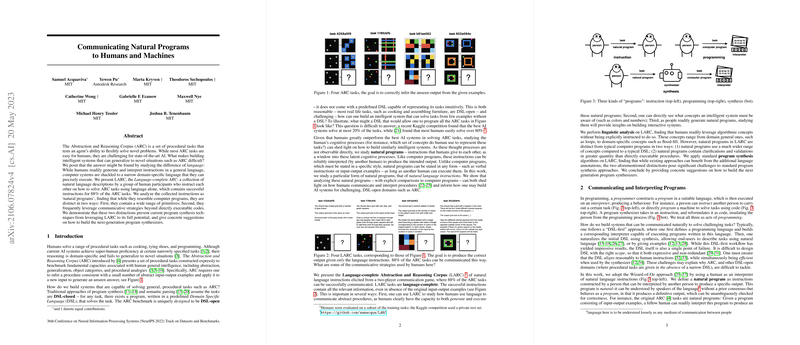Overview of "Communicating Natural Programs to Humans and Machines"
The paper "Communicating Natural Programs to Humans and Machines" explores the tasks set within the Abstraction and Reasoning Corpus (ARC), highlighting its challenges for AI agents while being straightforward for humans. The primary focus is on understanding the gap between how humans and machines process and communicate instructions for problem-solving. Humans excel in generating and interpreting general natural language instructions, whereas machines typically require domain-specific language (DSL) that limits their flexibility in novel situations.
To address these challenges, the authors introduce LARC (Language-complete ARC), a dataset comprising natural language instruction descriptions by human participants. These instructions succeeded in solving 88% of the ARC tasks, demonstrating the potential of language-rich methodologies. By analyzing these natural programs, the paper identifies two key differentiators from computer programs: a broader range of primitives and the usage of communicative strategies beyond directly executable codes. The inability of current program synthesis techniques to fully leverage LARC necessitates recommendations for the development of next-generation program synthesizers.
Key Findings and Contributions
- Human vs. Machine Problem Solving: The paper reinforces the notion that while humans can intuitively solve novel problems, machines struggle due to their reliance on DSLs specific to their programming.
- LARC Dataset: The introduction of LARC significantly extends the ARC, containing tasks solved via solely natural language instructions. Participants used a communication game setup where one participant describes, and another executes instructions, achieving communication success for 88% of ARC problems.
- Natural Programs: The authors propose that natural programs resemble computer programs but are distinct due to the richness and diversity of concepts. They include algorithmic concepts familiar in programming, such as loops and conditionals, but also span a broader range of unique primitives and human-like communicative strategies such as framing, validation, and clarification.
- Evaluation of Program Synthesis: Traditional program synthesis methods were applied to LARC, revealing significant limitations when dealing exclusively with natural language instructions. The research shows that while language annotations help, the effectiveness remains low, with the best model solving only 12% of test tasks.
- Concrete Suggestions for Future Systems: The paper concludes with practical recommendations for building robust program synthesizers that can better handle instructions involving a mix of linguistic and abstract concepts.
Implications and Speculation
The research has substantial implications for the development of AI capable of performing general problem-solving tasks akin to human reasoning. By uncovering the limitations of current AI techniques in processing natural language instructions, it paves the way for systems that are more adaptable and capable of generalization beyond fixed domains dictated by DSLs.
Future development in AI might further explore this interplay between natural language and computer-executable instructions, potentially leveraging LLMs in novel architectures that incorporate a deeper understanding of underlying cognitive processes. Such advancements will likely result in more flexible AI systems that can engage in interactive and human-like dialogues for task completion.
Conclusion
The paper marks a significant step in understanding the challenges of artificial general intelligence and gestures towards a future where AI systems can fluidly convert natural language instructions to executable solutions across diverse domains. The LARC dataset serves as a valuable resource and benchmark for these future advancements, fostering a symbiotic relationship between linguistic precision and computational logic.
